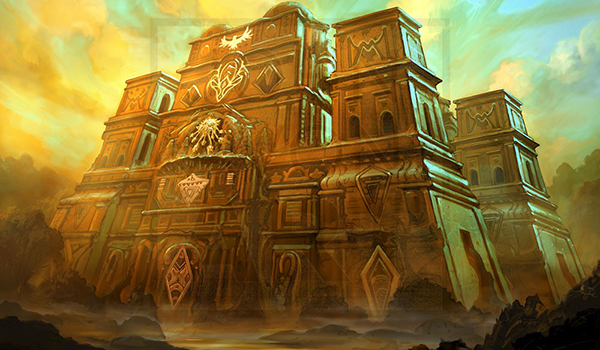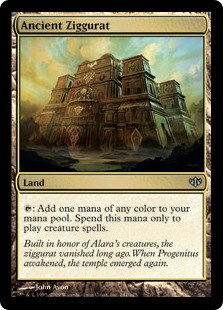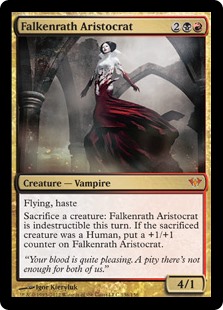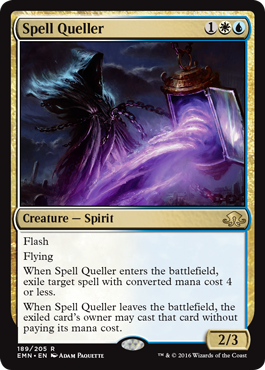Are you a Quiet Speculation member?
If not, now is a perfect time to join up! Our powerful tools, breaking-news analysis, and exclusive Discord channel will make sure you stay up to date and ahead of the curve.
Today's deck can perhaps most accurately be described as a motley pile of stuff. If you were paying attention last week, you may have seen this bizarre little deck pop up in the Top 8 of the Star City Games Columbus Classic in the hands of Jack Rumpf. Michael Kinney certainly took notice---he decided to run a list just one card off from Rumpf's in this weekend's Classic in Baltimore, where he finished 13th.

Somewhat blandly, SCG dubbed the deck "5-color Aggro," but I've decided to christen it with the more evocative name of "Rainbow Aggro." Either way, the deck's strangeness sort of speaks for itself. Take a look:
[wp_ad_camp_1]
Rainbow Aggro, by Michael Kinney (13th, SCG Classic Baltimore)
Rainbow Aggro's centerpiece feature is undoubtedly the mana base, headlined by kitchen-table and budget Magic all-star, Ancient Ziggurat. We're used to seeing five-color mana bases in combo decks that aim to end the game before the damage from Mana Confluence and the transient nature of  Gemstone Mine catch up to them. In a similar vein, this deck packs tons of efficient beaters that can deal twenty damage in short order. The nearly all-creature, all-gold spell suite opens up the possibility to run Ziggurat and Pillar of the Paruns. Rounding it all out are three Reflecting Pools, which basically always tap for every color, and the full 8 mana dorks.
Gemstone Mine catch up to them. In a similar vein, this deck packs tons of efficient beaters that can deal twenty damage in short order. The nearly all-creature, all-gold spell suite opens up the possibility to run Ziggurat and Pillar of the Paruns. Rounding it all out are three Reflecting Pools, which basically always tap for every color, and the full 8 mana dorks.
So what does this ambitious mana base do for us? Rainbow Aggro gets to run a veritable laundry list of the most efficiently-costed beaters and flexible utility creatures in the format. Gold cards are naturally pushed to begin with, and their natural drawback (difficulty to cast) is all but eliminated by this deck's innovative construction.
Most of these creatures are no stranger to Modern play, and the ones that are (Mantis Rider, Falkenrath Aristocrat) most likely just lack a viable shell. What's truly unique about this deck is its ability to jam all of these in lieu of the less-powerful options other aggro decks use to round out their creature suite. Every point on the curve is the absolute pinnacle of mana-to-value conversion, from Voice of Resurgence, to Spell Queller, to Siege Rhino. You can imagine a draw beginning on Noble Hierarch, followed by Mantis Rider into Siege Rhino will be pretty hard for the interactive decks to beat, and capable of racing many combo draws.
 The rainbow mana base doesn't just enable the biggest, meanest creatures---it also opens the door to some excellent disruption pieces. Tidehollow Sculler, Spell Queller, Qasali Pridemage, and Voice of Resurgence throw off an opponent's game plan and give Rainbow Aggro game against combo. The sideboard offers even more options for interaction and disruption with Fulminator Mage, Izzet Staticaster, and Gaddock Teeg. Post-board there are a myriad of configurations to position against aggro, combo, or control---and many tools to combat specific archetypes.
The rainbow mana base doesn't just enable the biggest, meanest creatures---it also opens the door to some excellent disruption pieces. Tidehollow Sculler, Spell Queller, Qasali Pridemage, and Voice of Resurgence throw off an opponent's game plan and give Rainbow Aggro game against combo. The sideboard offers even more options for interaction and disruption with Fulminator Mage, Izzet Staticaster, and Gaddock Teeg. Post-board there are a myriad of configurations to position against aggro, combo, or control---and many tools to combat specific archetypes.
Of course, this greedy mana base doesn't come for free. First of all, the cards Rainbow Aggro can run are severely restricted, which we see reflected in the sideboard of nearly all creatures. This phenomenon is also present in decks like Kiki Chord and Abzan Company whose signature tutor and selection effects demand a high creature count. But those decks generally have more sideboard flexibility than this one---Rainbow Aggro legitimately runs the risk of getting non-creatures stuck in hand. We see just the best in non-creature interaction as a result: Abrupt Decay and Path to Exile in the main, Stony Silence in the board.
The problem of uncastable spells can be exacerbated by opponents who attack the mana production directly. A well-timed Bolt on a Birds or Hierarch could spell disaster. To say nothing of the nightmare scenario of a resolved Blood Moon.
 Mulliganing with this deck might also be occasionally rough, if you fan out an opener of just Reflecting Pools and Pillar of the Paruns. Neither of those cards will cast a turn one Birds or Hierarch. I suspect this was what informed the sole change Kinney made to Rumpf's build from the week before, cutting a Pillar for the fourth Mana Confluence.
Mulliganing with this deck might also be occasionally rough, if you fan out an opener of just Reflecting Pools and Pillar of the Paruns. Neither of those cards will cast a turn one Birds or Hierarch. I suspect this was what informed the sole change Kinney made to Rumpf's build from the week before, cutting a Pillar for the fourth Mana Confluence.
I'm skeptical that this deck really boasts enough extra raw power and efficiency compared to traditional Zoo and Company builds to justify the sketchy mana. That said, as more creatures get printed in Modern the stock of Ancient Ziggurat et.al. goes up, and I wouldn't be surprised to see this archetype gather some steam in the future. After all, if you're the only deck that gets to run all the best creatures, you might just be able to pound-for-pound out-muscle the competition.
Announcing Modern Nexus Primers
Finally, I'm excited to announce a new project here at Modern Nexus: archetype primers! We've previously run primers on specific decks in the past, but never compiled all the major archetypes together in one place before. The goal is to provide a one-stop resource for anyone looking to get into Modern for the first time or explore a new archetype. These primers will offer in-depth strategic advice on metagame positioning, key plays, sideboarding, and the strengths and weaknesses of different variants.
This is something of a long-term goal, and I'm not sure what the time frame will be. In any case, we're looking for help from archetype specialists in the Modern community to write these primers. If you're highly experienced with a certain deck or style of deck and interested in sharing your wisdom, we'd love to hear from you! Contact me at jason@quietspeculation.com for more information.




Interesting to see that the Rainbow Aggro wasn’t a one-hit wonder. The manabase is complicated (and is one Blood Moon/Spreading Seas away from disaster in a lot of hands, I’m sure), but not every deck packs that kind of hate, and against the ones who don’t, it could be a bear to deal with.
I’m also very excited about the Primers series.
Re: the primers, are you planning to cover only current and prior tier 1s, or will the larger variety of tier 2s be game for primer production?
Eventually I’d like to offer a primer on every archetype in Modern, but for now the priority will be on Tier 1 and Tier 2 decks, as defined by our Top Decks page. Much of the Magic community uses the term “tier” differently than us—our top two tiers cover 18 decks at the moment, which seems like a good starting point.
Excellent! If you decide you want a primer on different builds of Faeries, I worked in that shell in all its iterations that seem reasonable (UB, UR, UBR, UBW, UBG) and I’d be happy to prepare a primer on the different strengths and options each configuration has to offer.
If you ever need help on a Death & Taxes / Hatebears primer, I happen to be really knowledgeable on both of these decks and all of their variants (including the almost unknown azorius and boros ones) and I would be more than happy to share my thoughts, anecdotes, experiments, tips and tricks (and metagame building obviously) about the archetype I’ve found so far!
If you are somehow interested in this, just ask me either here, or directly on Facebook or even tappedout.net (where I am known as elpokitolama). 🙂
Back to the deck of the week: that is interesting, I met two years ago a list that even took advantage of the multicolored aspects of its cards thanks to cards like Knight of New Alara and the Blade common cycle of the Alara Reborn set. It was really a blast playing against, even thought the deck was easily disruptable.
Primers sound alright but really hoping for a good deck database. Dont know how much you could improve on mtg goldfish database – but being able to look by both event and card would be good as well as not deleting records as often (or at all)